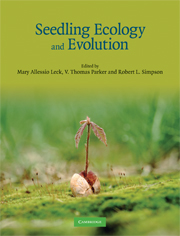Book contents
- Frontmatter
- Contents
- Contributors
- Foreword by Peter J. Grubb
- Preface
- Acknowledgments
- Part I Introduction
- Part II Seedling diversity
- Part III Seedling morphology, evolution, and physiology
- Part IV Life history implications
- Part V Applications
- Chapter 14 Does seedling ecology matter for biological invasions?
- Chapter 15 The role of seedlings in the dynamics of dryland ecosystems – their response to and involvement in dryland heterogeneity, degradation, and restoration
- Chapter 16 Anthropogenic disturbance in tropical forests: toward a functional understanding of seedling responses
- Chapter 17 Seedling establishment in restored ecosystems
- Part VI Synthesis
- References
- Index
Chapter 17 - Seedling establishment in restored ecosystems
Published online by Cambridge University Press: 05 June 2012
- Frontmatter
- Contents
- Contributors
- Foreword by Peter J. Grubb
- Preface
- Acknowledgments
- Part I Introduction
- Part II Seedling diversity
- Part III Seedling morphology, evolution, and physiology
- Part IV Life history implications
- Part V Applications
- Chapter 14 Does seedling ecology matter for biological invasions?
- Chapter 15 The role of seedlings in the dynamics of dryland ecosystems – their response to and involvement in dryland heterogeneity, degradation, and restoration
- Chapter 16 Anthropogenic disturbance in tropical forests: toward a functional understanding of seedling responses
- Chapter 17 Seedling establishment in restored ecosystems
- Part VI Synthesis
- References
- Index
Summary
Introduction
Over the past two decades, ecological restoration has progressed to rely on more refined techniques, to include a greater array of ecosystems, and to attempt larger and more complex problems. Despite this progress, the outcome of many restorations fails to result in ecosystems that are similar to their natural counterparts. Restored ecosystems typically have fewer species and do not accumulate species over time, as expected. A lack of available seeds or suitable microsites for seedling establishment can hinder community development. Not surprisingly, seed availability is more often reported to be the key limitation to higher richness (e.g. Pywell et al., 2002; Martin & Wilsey, 2006; Kettenring, 2006). Most restorations introduce a small subset of the species expected and often at much lower abundances than exist in unaltered sites. To do otherwise seldom has been considered necessary because dispersal has the potential to add species over time. Unfortunately, habitat fragmentation has diminished native species propagule pressure and hinders dispersal in many landscapes (Galatowitsch & van der Valk, 1996; Honnay et al., 2002; Young et al., 2005) leading to increased recognition of the importance of adequate seed introductions for restorations.
When the investment in acquiring native seed for restoration is significant, there needs to be a reasonable likelihood that conditions are suitable for seedling emergence and growth. This can be especially challenging considering that site conditions at the start of a restoration project can be radically different than what might have ever existed in an unaltered community, even after natural disturbances.
Information
- Type
- Chapter
- Information
- Seedling Ecology and Evolution , pp. 352 - 370Publisher: Cambridge University PressPrint publication year: 2008
Accessibility standard: Unknown
- 5
- Cited by
